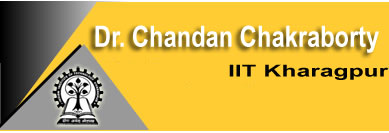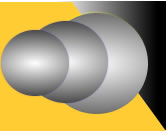 |
Research
My team works in the areas of (i) power converters, (ii) industrial drives (iii) electric machines and (iv) renewable energy integration. Contributions on some of the topics are highlighted here.
In power electronics we proposed new topological configurations and control techniques of multi level converters, active power filters/static VAR compensators and resonant converters. Our contributions in industrial drives include proposal of new series of adaptive controllers for speed and parameter estimation of induction motor drives and development of fault tolerant controllers. In electric machines, we have shown the influence of parameter variation on parallel-operated self excited induction generators. Our recent work on magnet-less and bush-less machines have huge application in renewable energy harnessing in remote rural areas. Specific details of these investigations follow:
1. Power Converters:
We have proposed a new concept of level doubling network to almost double the number of voltage levels at the output of a multi level converter (MLC) [1]. This idea has opened up a series of new topologies for MLCs improving voltage quality and requiring less number of devices. Specific applications are explored for solar PV systems. We have also worked on symmetrical and asymmetrical cascaded bridge (CHB) topologies for MLCs and proposed new method of analysis to find the number of space vectors available to realize a certain voltage output. Limit Chart [2] that shows a 2-dimensional representation of such space vector redundancies is proposed for the first time. The concept of Limit Chart opens up a new method of understanding MLCs. The possibility of controlling the optimal ratio MLC by asymmetrical hexagonal decomposition is demonstrated [2].
In static compensators (STATCOM) and active power filters, we worked on the use of twin inverters, one to switch at low frequency and another at higher frequency to optimize loss and performance [3]. In active power filter, the key idea here is to use hybrid configuration those are tuned at 5th and 7th harmonics for low frequency inverter and 11th and 13th harmonics for the high frequency inverter respectively. Performance of synchronously rotating reference frame based controllers and also ANN based (using predictive and adaptive algorithms to improve the transient performance) are demonstrated for the active power filters [4]. Later we have extended the work for solar PV applications for active power injection to the grid during day time (including maximum power point tracking (MPPT)) and reactive power regulation in the absence of solar irradiance.
In resonant converters we have presented a new approach to utilize the transformer parameters to replace the inductor in the network and thus optimize system behavior reducing size and cost [5]. Contrary to the most used LCC converter, we have first shown through a systematic study that CLL is having unique features those make this most suitable for transformer-isolated applications. We have investigated in detail on the design optimization and control of such converters. Moreover, we have proposed the concept of Controlled Capacitor Charging (CCC) type inverters [6-7].
2. Industrial Drives:
In motor drives, we made contributions on the control and parameter estimation of induction motor (IM) drives. We have proposed new techniques to eliminate the speed sensor of vector controlled drive increasing robustness and reducing cost [8]. Our major contribution is to propose new model reference adaptive controllers (MRAC) using reactive power (Q) as the functional candidate. Instantaneous and steady state Q are used to form the MRAC. The proposed algorithm is only influenced by rotor time constant and in fact by modifying the algorithm we have shown that rotor resistance may be estimated in case speed signal is available [9]. Attempts are put to improve the performance of the controller in the motoring mode and a detailed stability study is also reported. A four quadrant control is demonstrated using ANN. This is a unique example where classical control and soft computing are properly hybridized for enhancing stability of a system [10]. We have recently proposed a new candidate X (which is the outer product of terminal voltage and current) for such adaptive controllers. X has no physical significance unlike active (P) or reactive (Q) power. It has been shown that X-based controllers are inherently stable in all the four quadrants of operation and demonstrate excellent performance at low operating speed [11]. Very recently we proposed a series of model reference adaptive controllers (MRAC) those can work stably in all the four quadrant of operation. In particular, we have introduced a new configuration of Q-based MRAC and proved it’s supremacy over all available configurations [8].
Our work on efficiency optimization is a hybrid technique of loss model and search based approaches [12]. This has the merits of fast convergence and immunity to parameter variation. Recently, we have proposed a new current estimation technique (for the vector controlled drives) that is independent of inverter switching states, does not require an additional sensor and is independent of parameter variation [13]. Utilizing the speed and current estimation techniques and introducing a new phasor rotation concept, we have proposed a unique fault tolerant controller that can operate even in case of multiple sensor failures [14]. My team also developed low cost FPGA based controllers for the IM drives.
3. Electric Machines:
In early stage of my career, I worked on induction generators. We have used inverse- model of the machine to explore the limiting behavior of self excited induction generator in a systematic manner [15]. We have for the first time investigated the load sharing of individual generators when operated in parallel and have demonstrated that rotor resistance is the most important parameter for such machines [16]. We have also proposed a simple test for the existence of self excitation. This method is later published in book. We are presently working on brushless generator using multiple winding induction machines for applications in distributed generation [17].
Recently we are working on brushless and permanent magnet-less machines. Double winding induction generators [18] are studied for possible applications in dc grid systems. Two new brushless synchronous machines (BINSIG and SEBSE) are patented. While in one, the excitation winding is fed from an embedded induction machine (BINSYG), in the other, it is through a reverse cascaded and embedded synchronous machine (SEBSE) [19]. The following figure shows a laboratory prototype of a BINSIG.

Figure: Lab prototype of BINSYG
4. Renewable Energy:
Our recent focus is on renewable energy integration to the grid. A laboratory model for the hybrid AC/DC micro grid is under development. Through such model, investigations related to supervisory control in microgrid, storage optimization, influence of different time-scale storage on grid-frequency-control etc, are going on. The focus in dc microgrid is high-gain and bidirectional dc/dc converters, series voltage regulator, power flow controller etc.. While for ac microgrid, effect of unbalance, unified controller for off-on grid applications, Interlinking converter (to interconnect ac/dc microgrid and storage) and new multi level inverter topologies for solar power evacuation are the topic of interest [20, 21].
References:
S.K.Chattopadhyay and C.Chakraborty, "A New Multi Level Inverter Topology with Self Balancing Level Doubling Network," IEEE Trans. on Industrial Electronics, Vol.61, No.9, pp.4622-4631, 2014. S. K. Chattopadhyay and C. Chakraborty, “Performance of Three-Phase Asymmetric Cascaded Bridge (16:4:1) Multilevel Inverter,” IEEE Trans. on Industrial Electronics, In Press (2015). A.Bhattacharya, C.Chakraborty and S.Bhattacharya, “Parallel Connected Shunt Hybrid Active Power Filters Operating at Different Switching Frequencies for Improved Performance,” IEEE Trans. on Industrial Electronics, Vol. 59, pp. 4007-4019, 2012. A.Bhattacharya and C.Chakraborty, “A Shunt Active Power Filter with Enhanced Performance Using ANN based Predictive and Adaptive Controllers,” IEEE Trans. on Industrial Electronics, vol. 58, No. 2, pp. 421-428, 2011. C.Chakraborty, M.Ishida and Y.Hori, “Novel Half-Bridge Resonant Converter Topology Realized by Adjusting Transformer Parameters,” IEEE Trans. on Industrial Electronics Vol.49, No.1, pp.197-205, 2002. C.Chakraborty, S. Dalapati and S.Bhattacharya “Performance Evaluation of Controlled Capacitor Charging Type Inverters,” IEEE Trans. on Industrial Electronics, Vol.56, No.1, pp.12-19, 2009. S. Dalapati and C.Chakraborty, “A Direct PWM Technique for a Single-Phase Full-Bridge Inverter through Controlled Capacitor Charging,” IEEE Trans. on Industrial Electronics, Vol.55, No.8, pp.2912-2922, 2008. A.V.Ravi Teja, V. Verma and C.Chakraborty, “A New Formulation of Reactive Power Based Model Reference Adaptive System for Sensorless Induction Motor Drive,” IEEE Trans. on Industrial Electronics, In Press (2015). S.Maiti, C.Chakraborty et. al., “Model Reference Adaptive Controller-Based Rotor Resistance and Speed Estimation Techniques for Vector Controlled Induction Motor Drive utilizing Reactive Power,” IEEE Trans. on Industrial Electronics, Vol.55, No.2, pp.594-601, 2008. S.Maiti, V.Verma, C.Chakraborty, and Y.Hori, “An adaptive speed sensorless induction motor drive with artificial neural network for stability enhancement,” IEEE Trans. on Industrial Informatics, vol. 8, no. 4, pp.757–766, Nov. 2012. A.V.Ravi Teja, C.Chakraborty, S.Maiti, and Y.Hori, “A New Model Reference Adaptive Controller for Four Quadrant Vector Controlled Induction Motor Drives,” IEEE Trans. on Industrial Electronics, Vol. 59, No. 10, pp. 3757-3767, Oct. 2012. C.Chakraborty and Y.Hori, “Fast Efficiency Optimization Techniques for the Indirect Vector-Controlled Induction Motor Drives,” IEEE Trans. on Industry Applications, Vol.39, No.4, pp.1070-1076, 2003. V.Verma, C.Chakraborty, S.Maiti, and Y.Hori, “Speed sensorless vector controlled induction motor drive using single current sensor,” IEEE Trans. on Energy Conversion, Vol.28, No.4, pp.938-950, 2013. C.Chakraborty and V. Verma, “Speed and Current Sensor Fault Detection and Isolation Technique for Induction Motor Drive Using Axes Transformation,” IEEE Trans. on Industrial Electronics, Vol.62, No.3, pp.1943-1954, 2015. C.Chakraborty, S.N.Bhadra and A.K.Chattopadhyay, “Excitation Requirements of Three Phase Induction Generators,” IEEE Trans. on Energy Conversion, Vol.13, No.4 pp.358-365, 1998. C.Chakraborty, S.N.Bhadra and A.K.Chattopadhyay, “Analysis of Parallel-Operated Self-Excited Induction Generators,” IEEE Trans. on Energy Conversion, Vol.14, No.2 pp.209-216, 1999. S. Basak and C. Chakraborty, “Dual Stator Winding Induction Machines: Problems, Progress and Future Scope,” IEEE Trans. on Industrial Electronics, Vol.62, No.7, pp.4641-4652, 2015. S. Basak and C. Chakraborty, “A New Optimal Current Control Technique for Dual Stator Winding Induction Generator,” IEEE Journal of Emerging and Selected Topics in Power Electronics, Vol.5, No.2, pp. 820-832, 2017. C. Chakraborty, S. Basak and Y. T. Rao, “A new series of brushless and permanent magnetless synchronous machines,” IEEE ISIE, 2017, pp.1425-1430 N. R. Merritt, C. Chakraborty, P. Bajpai, “New Voltage Control Strategies for VSC based DG Units in an Unbalanced Microgrid,” IEEE Transactions on Sustainable Energy, Vol.8, No.3, pp. 1127-1136, 2017. S. K. Chattopadhyay and C. Chakraborty, “A New Asymmetric Multilevel Inverter Topology Suitable for Solar PV Applications with Varying Irradiance,” IEEE Transactions on Sustainable Energy, Vol. 8, No.4, pp. 1496-1506, 2017.
Patents:
C. Chakraborty and V.Verma, Fault Tolerant Control for Vector Controlled Induction Motor Drive : Indian Patent (Ref : 1067/KOL/2012 ) C. Chakraborty and S.K.Chattopadhyay, H-bridge Based Level Doubling Circuit for Cascaded H-bridge Multi Level Inverters : Indian Patent (Ref : 0125/KOL/2012 ) C. Chakraborty, V.Verma, and A.V.Ravi Teja, Single Current Sensor Based Speed Sensorless Vector Controlled Induction Motor Drive : Indian Patent (Ref : 1068/KOL/2012 ) C. Chakraborty, Y. T. Rao, S. Sengupta and S. Basak, “Brushless induction excited synchronous generator” Indian Patent. (Ref: 201631039892). S.K. Chattopadhyay and C. Chakraborty, "Fault Tolerant Voltage Source Converter Systems" Indian Patent (Ref: 201731018873). C. Chakraborty, S. Basak and Y.T. Rao, “Synchronous Machine with Embedded Brushless Synchronous Exciter” Indian Patent. (Ref: 201731033722).
|
 |
|
 |



